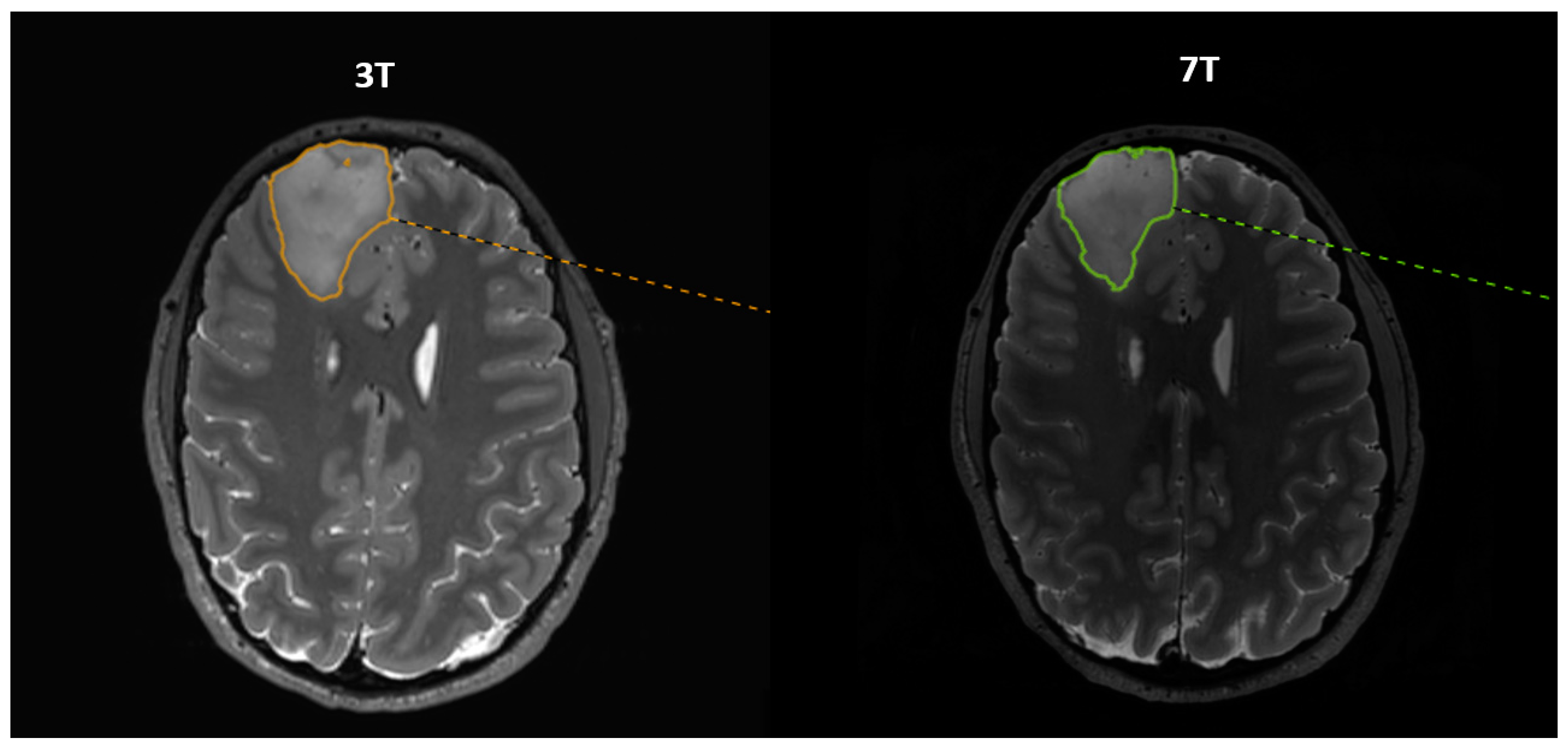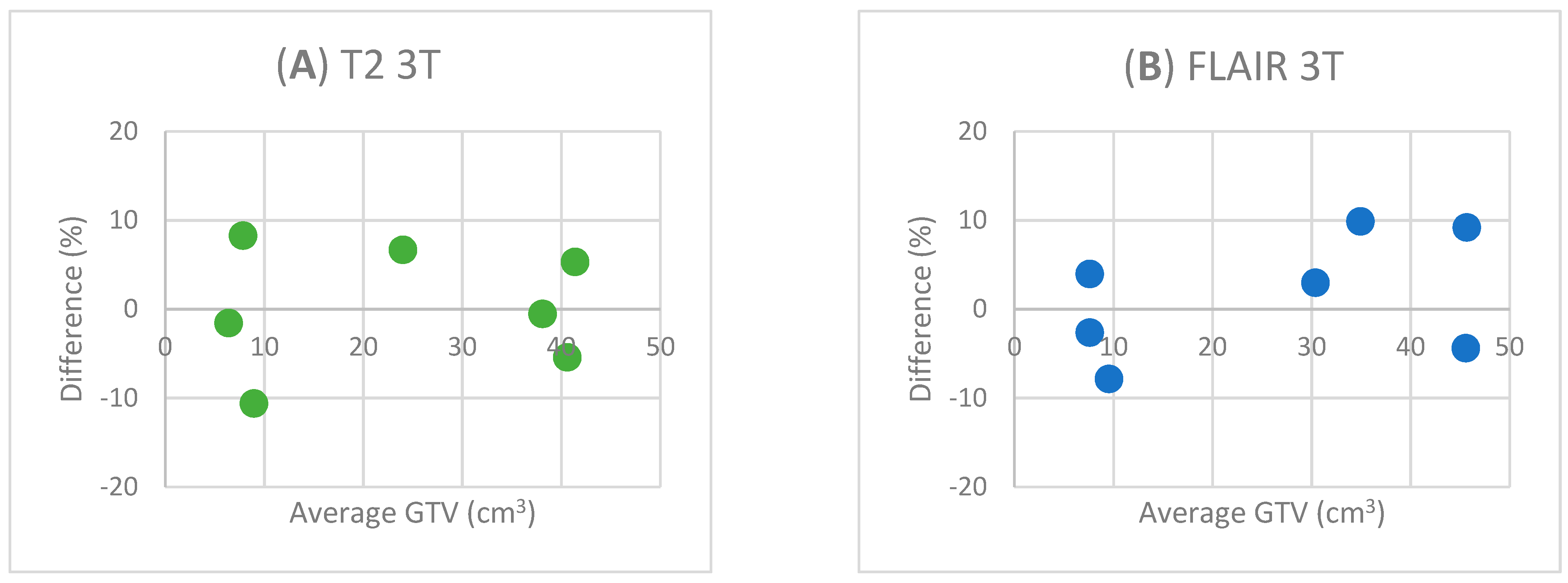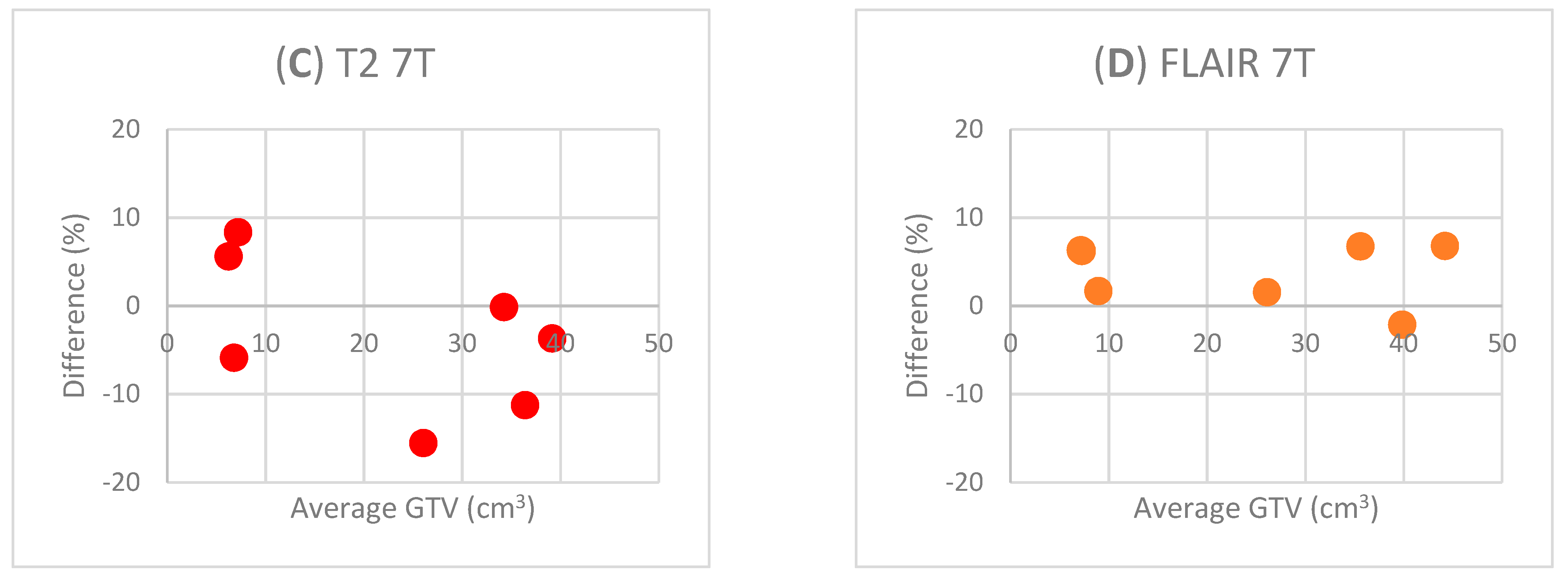Delineation of Grade II and III Gliomas Investigated by 7T MRI: An Inter-Observer Pilot Study
Abstract
1. Introduction
Delineation of DLGGs on 7 Tesla MR Images
2. Methods
2.1. Patient Population
2.2. Comments on Histopathology of Patients
2.3. MRI Protocol
2.4. Analysis
3. Results
4. Discussion
4.1. Delineation of Tumor Borders and Infiltration
4.2. Inter-Observer Agreement
4.3. Differences and Challenges in Clinical 7T MRI
5. Conclusions
Supplementary Materials
Author Contributions
Funding
Institutional Review Board Statement
Informed Consent Statement
Data Availability Statement
Acknowledgments
Conflicts of Interest
References
- Delgado-López, P.D.; Corrales-García, E.M.; Martino, J.; Lastra-Aras, E.; Dueñas-Polo, M.T. Diffuse low-grade glioma: A review on the new molecular classification, natural history and current management strategies. Clin. Transl. Oncol. 2017, 19, 931–944. [Google Scholar] [CrossRef] [PubMed]
- Schiff, D. Low-grade Gliomas. Continuum (Minneap Minn) 2017, 23, 1564–1579. [Google Scholar] [CrossRef] [PubMed]
- Louis, D.N.; Perry, A.; Reifenberger, G.; Von Deimling, A.; Figarella-Branger, D.; Cavenee, W.K.; Ohgaki, H.; Wiestler, O.D.; Kleihues, P.; Ellison, D.W. The 2016 world health organization classification of tumors of the central nervous system: A summary. Acta Neuropathol. 2016, 131, 803–820. [Google Scholar] [CrossRef]
- Louis, D.N.; Perry, A.; Wesseling, P.; Brat, D.J.; Cree, I.A.; Figarella-Branger, D.; Hawkins, C.; Ng, H.K.; Pfister, S.M.; Reifenberger, G.; et al. The 2021 WHO Classification of Tumors of the Central Nervous System: A summary. Neuro-Oncology 2021, 23, 1231–1251. [Google Scholar] [CrossRef] [PubMed]
- Olar, A.; Wani, K.M.; Alfaro-Munoz, K.D.; Heathcock, L.E.; van Thuijl, H.F.; Gilbert, M.R.; Armstrong, T.S.; Sulman, E.P.; Cahill, D.P.; Vera-Bolanos, E.; et al. IDH mutation status and role of WHO grade and mitotic index in overall survival in grade II–III diffuse gliomas. Acta Neuropathol. 2015, 129, 585–596. [Google Scholar] [CrossRef]
- Reuss, D.E.; Mamatjan, Y.; Schrimpf, D.; Capper, D.; Hovestadt, V.; Kratz, A.; Sahm, F.; Koelsche, C.; Korshunov, A.; Olar, A.; et al. IDH mutant diffuse and anaplastic astrocytomas have similar age at presentation and little difference in survival: A grading problem for WHO. Acta Neuropathol. 2015, 129, 867–873. [Google Scholar] [CrossRef]
- Duffau, H.; Taillandier, L. New concepts in the management of diffuse low-grade glioma: Proposal of a multistage and individualized therapeutic approach. Neuro-Oncology 2015, 17, 332–342. [Google Scholar] [CrossRef]
- Jakola, A.; Skjulsvik, A.; Myrmel, K.; Sjåvik, K.; Unsgård, G.; Torp, S.; Aaberg, K.; Berg, T.; Dai, H.; Johnsen, K.; et al. Surgical resection versus watchful waiting in low-grade gliomas. Ann. Oncol. 2017, 28, 1942–1948. [Google Scholar] [CrossRef]
- Yordanova, Y.N.; Moritz-Gasser, S.; Duffau, H. Awake surgery for WHO Grade II gliomas within “noneloquent” areas in the left dominant hemisphere: Toward a “supratotal” resection. J. Neurosurg. 2011, 115, 232–239. [Google Scholar] [CrossRef]
- Eisenhut, F.; Schlaffer, S.-M.; Hock, S.; Heynold, E.; Kremenevski, N.; Bluemcke, I.; Buchfelder, M.; Doerfler, A.; Schmidt, M.A. Ultra-High-Field 7 T Magnetic Resonance Imaging Including Dynamic and Static Contrast-Enhanced T1-Weighted Imaging Improves Detection of Secreting Pituitary Microadenomas. Investig. Radiol. 2022, 57, 567–574. [Google Scholar] [CrossRef]
- Obusez, E.C.; Lowe, M.; Oh, S.-H.; Wang, I.; Bullen, J.; Ruggieri, P.; Hill, V.; Lockwood, D.; Emch, T.; Moon, D.; et al. 7T MR of intracranial pathology: Preliminary observations and comparisons to 3T and 1.5T. Neuroimage 2018, 168, 459–476. [Google Scholar] [CrossRef] [PubMed]
- van der Kolk, A.G.; Hendrikse, J.; Zwanenburg, J.J.M.; Visser, F.; Luijten, P.R. Clinical applications of 7T MRI in the brain. Eur. J. Radiol. 2013, 82, 708–718. [Google Scholar] [CrossRef] [PubMed]
- Regnery, S.; Knowles, B.R.; Paech, D.; Behl, N.; Meissner, J.-E.; Windisch, P.; Ben Harrabi, S.; Bernhardt, D.; Schlemmer, H.-P.; Ladd, M.E.; et al. High-resolution FLAIR MRI at 7 Tesla for treatment planning in glioblastoma patients. Radiother. Oncol. 2019, 130, 180–184. [Google Scholar] [CrossRef]
- Zetterling, M.; Roodakker, K.R.; Berntsson, S.G.; Edqvist, P.-H.; Latini, F.; Landtblom, A.-M.; Pontén, F.; Alafuzoff, I.; Larsson, E.-M.; Smits, A. Extension of diffuse low-grade gliomas beyond radiological borders as shown by the coregistration of histopathological and magnetic resonance imaging data. J. Neurosurg. 2016, 125, 1155–1166. [Google Scholar] [CrossRef] [PubMed]
- Pallud, J.; Capelle, L.; Taillandier, L.; Fontaine, D.; Mandonnet, E.; Guillevin, R.; Bauchet, L.; Peruzzi, P.; Laigle-Donadey, F.; Kujas, M.; et al. Prognostic significance of imaging contrast enhancement for WHO grade II gliomas. Neuro-Oncology 2009, 11, 176–182. [Google Scholar] [CrossRef]
- Scott, J.N.; Brasher, P.M.; Sevick, R.J.; Rewcastle, N.B.; Forsyth, P.A. How often are nonenhancing supratentorial gliomas malignant? A population study. Neurology 2002, 59, 947–949. [Google Scholar] [CrossRef] [PubMed]
- Opheim, G.; Boer, V.O.; Petersen, E.T.; Prener, M.; Paulson, O.B.; Pedersen, J.O. Stabilization of bias field on 3D MPRAGEat 7T with dielectric pads and 3D-based B1+ scaling. In Proceedings of the 2021 ISMRM & SMRT Annual Meeting & Exhibition, online, 15–20 May 2021. [Google Scholar]
- Andersen, M.; Björkman-Burtscher, I.; Marsman, A.; Petersen, E.T.; Boer, V. Improvement in diagnostic quality of structural and angiographic MRI of the brain using motion correction with interleaved, volumetric navigators. PLoS ONE 2019, 14, e0217145. [Google Scholar] [CrossRef]
- Zwanenburg, J.J.M.; Hendrikse, J.; Visser, F.; Takahara, T.; Luijten, P.R. Fluid attenuated inversion recovery (FLAIR) MRI at 7.0 Tesla: Comparison with 1.5 and 3.0 Tesla. Eur. Radiol. 2010, 20, 915–922. [Google Scholar] [CrossRef]
- Hambardzumyan, D.; Gutmann, D.H.; Kettenmann, H. The role of microglia and macrophages in glioma maintenance and progression. Nat. Neurosci. 2016, 19, 20–27. [Google Scholar] [CrossRef]
- Quail, D.F.; Joyce, J.A. The Microenvironmental Landscape of Brain Tumors. Cancer Cell 2017, 31, 326–341. [Google Scholar] [CrossRef]
- Hara, T.; Inoue, Y.; Ukisu, R.; Hata, H. Methods for optimizing the display conditions of brain magnetic resonance images. Jpn. J. Radiol. 2017, 35, 622–627. [Google Scholar] [CrossRef] [PubMed]
- Nyúl, L.G.; Udupa, J.K. On standardizing the MR image intensity scale. Magn. Reson. Med. 1999, 42, 1072–1081. [Google Scholar] [CrossRef]
- Gerin, C.; Pallud, J.; Deroulers, C.; Varlet, P.; Oppenheim, C.; Roux, F.-X.; Chrétien, F.; Thomas, S.R.; Grammaticos, B.; Badoual, M. Quantitative characterization of the imaging limits of diffuse low-grade oligodendrogliomas. Neuro-Oncology 2013, 15, 1379–1388. [Google Scholar] [CrossRef] [PubMed]



| Observer 1 | Observer 2 | |||||
|---|---|---|---|---|---|---|
| Pt. No. | GTV cm3 3T | GTV cm3 7T | GTV cm3 Difference (%) * | GTV cm3 3T | GTV cm3 7T | GTV cm3 Difference (%) * |
| 1 | 25.6 | 22.0 | 3.6 (14.1) | 22.4 | 30.1 | −7.7 (−34.4) |
| 2 | 38.4 | 32.3 | 6.1 (15.9) | 42.8 | 40.5 | 2.3 (5.4) |
| 3 | 6.3 | 6.4 | −0.1 (−1.6) | 6.5 | 7.2 | −0.7 (−10.8) |
| 4 | 8.0 | 6.6 | 1.4 (17.5) | 9.9 | 5.9 | 4.0 (40.4) |
| 5 | 43.6 | 37.7 | 5.9 (15.6) | 39.2 | 40.6 | −1.4 (−3.6) |
| 6 | 37.9 | 34.2 | 3.7 (10.8) | 38.3 | 34.3 | 4.0 (10.4) |
| 7 | 8.5 | 7.8 | 0.7 (9.0) | 7.2 | 6.6 | 0.6 (8.3) |
| Observer 1 | Observer 2 | |||||
|---|---|---|---|---|---|---|
| Pt. No. | GTV cm3 3T | GTV cm3 7T | GTV cm3 Difference (%) * | GTV cm3 3T | GTV cm3 7T | GTV cm3 Difference (%) * |
| 1 | 31.3 | 26.5 | 4.8 (15.3) | 29.5 | 25.7 | 3.8 (12.9) |
| 2 | 43.6 | 39.0 | 4.6 (10.6) | 47.6 | 40.7 | 6.9 (14.5) |
| 3 | 7.9 | 7.7 | 0.2 (2.5) | 7.3 | 6.8 | 0.5 (6.8) |
| 4 | 8.8 | 9.1 | −0.3 (−3.4) | 10.3 | 8.8 | 1.5 (14.6) |
| 5 | 49.9 | 47.2 | 2.7 (5.7) | 41.5 | 41.2 | 0.3 (0.7) |
| 6 | 38.4 | 38.0 | 0.4 (1.1) | 31.5 | 33.2 | −1.7 (−5.4) |
| 7 | 7.4 | 7.6 | 0.2 (2.6) | 7.8 | 6.7 | 1.1 (14.1) |
| ICC | Average Volume (cm3) | Mean Difference between Observers ± SD (cm3) | Mean Difference between Observers in % ± SD in % | |
|---|---|---|---|---|
| All | 0.969 | 24.1 | 2.74 ± 2.67 | 11.6 ± 6.92 |
| T2 | 0.972 | 23.1 | 2.70 ± 2.72 | 12.4 ± 7.77 |
| FLAIR | 0.980 | 25.0 | 2.79 ± 2.71 | 10.8 ± 6.15 |
| 3T | 0.975 | 24.9 | 2.81 ± 2.54 | 11.6 ± 6.66 |
| 7T | 0.966 | 23.2 | 2.67 ± 2.89 | 11.6 ± 7.43 |
| T2 (3T) | 0.983 | 23.9 | 2.26 ± 1.77 | 11.0 ± 6.44 |
| T2 (7T) | 0.977 | 22.3 | 3.14 ± 3.53 | 13.7 ± 8.20 |
| FLAIR (3T) | 0.972 | 25.9 | 3.37 ± 3.18 | 12.1 ± 6.34 |
| FLAIR (7T) | 0.989 | 24.2 | 2.20 ± 2.25 | 9.5 ± 5.15 |
Disclaimer/Publisher’s Note: The statements, opinions and data contained in all publications are solely those of the individual author(s) and contributor(s) and not of MDPI and/or the editor(s). MDPI and/or the editor(s) disclaim responsibility for any injury to people or property resulting from any ideas, methods, instructions or products referred to in the content. |
© 2023 by the authors. Licensee MDPI, Basel, Switzerland. This article is an open access article distributed under the terms and conditions of the Creative Commons Attribution (CC BY) license (https://creativecommons.org/licenses/by/4.0/).
Share and Cite
Prener, M.; Opheim, G.; Simonsen, H.J.; Engelmann, C.M.; Ziebell, M.; Carlsen, J.; Paulson, O.B. Delineation of Grade II and III Gliomas Investigated by 7T MRI: An Inter-Observer Pilot Study. Diagnostics 2023, 13, 1365. https://doi.org/10.3390/diagnostics13081365
Prener M, Opheim G, Simonsen HJ, Engelmann CM, Ziebell M, Carlsen J, Paulson OB. Delineation of Grade II and III Gliomas Investigated by 7T MRI: An Inter-Observer Pilot Study. Diagnostics. 2023; 13(8):1365. https://doi.org/10.3390/diagnostics13081365
Chicago/Turabian StylePrener, Martin, Giske Opheim, Helle Juhl Simonsen, Christina Malling Engelmann, Morten Ziebell, Jonathan Carlsen, and Olaf B. Paulson. 2023. "Delineation of Grade II and III Gliomas Investigated by 7T MRI: An Inter-Observer Pilot Study" Diagnostics 13, no. 8: 1365. https://doi.org/10.3390/diagnostics13081365
APA StylePrener, M., Opheim, G., Simonsen, H. J., Engelmann, C. M., Ziebell, M., Carlsen, J., & Paulson, O. B. (2023). Delineation of Grade II and III Gliomas Investigated by 7T MRI: An Inter-Observer Pilot Study. Diagnostics, 13(8), 1365. https://doi.org/10.3390/diagnostics13081365







